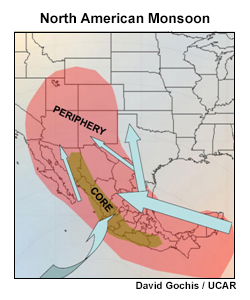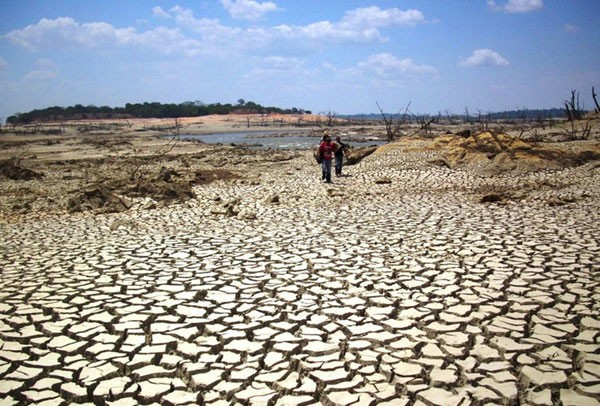While news headlines have focused on the atmospheric rivers that flooded parts of California this winter, few have noticed that the North American monsoon region has become unusually dry.
Each year, the North American monsoon brings crucial rainfall to western Mexico and the southwestern United States. The monsoon has a significant impact on the lives of the 12 million people living within its reach, as it accounts for a large portion of the annual rainfall necessary to sustain life and support agriculture in the region. Specifically, the North American monsoon brings 60-80% of the northwestern Mexico’s annual precipitation, and 35-45% of the annual precipitation of Arizona and New Mexico.

The North American monsoon begins in southern Mexico around June of each year. Heavy rainfall then expands north through the mountains of the Sierra Madre Occidental mountain range. When the monsoon arrives, weather conditions change from hot and arid to cool and wet. This can occur as early as June in Mexico or July in Arizona or New Mexico. As the monsoon progresses, rainfall tends to intensify and dangerous effects of hydrological extremes become more likely. The most severe rainfall usually occurs in the Gulf of California or Sierra Madre Occidental maintain range, where average monthly rainfall is 12 inches. Here, heavy rains transform “near desert conditions to those typical of a tropical rain forest within several weeks,” according to the National Oceanic and Atmospheric Administration. When the monsoon season has concluded, parts of Mexico and the western United States experience a mid-summer drought of varying length and severity.
Although the heaviest rains are usually concentrated in these two areas, monsoon storms are dispersed throughout the region and their severity often depends on a number of influencing factors changing from year to year. These include the position of waves in the midlatitude jet stream and ocean surface temperatures — both influence rainfall patterns and severity. The nature and magnitude of each year’s monsoon significantly affects agriculture and farming, the health of ecosystems, and the likelihood of wildfires in the western North American region.


So far this year, the Western U.S. has seen above-average rainfall, and all of North America outside of the Pacific Northwest has seen anomalously high temperatures. In Phoenix, Arizona, for example, rain levels and temperatures exceeded monthly averages by 0.32 inches and 2.2 degrees Fahrenheit, respectively. But while California has been receiving significant media attention for its torrential rainfall and floods, droughts in western Mexico have been developing.
Western Mexico is currently experiencing a rainfall deficit. Although experiencing heavier than usual rains this past summer, the region has been unusually dry through the winter months. The North American Drought Monitor has classified this region as “Abnormally Dry”, the result of a 40 millimeter rainfall deficit. While this deficit does not yet constitute a widespread drought, severe drought has started to occur in isolated regions such as the Mexican state of Oaxaca.

Oaxaca’s Isthmus region is currently facing its worst drought in five decades. Drought conditions have resulted in low agricultural yields, economic woes, and severe water shortages throughout the region. The Isthmus accounts for over half of the state’s cattle production, and already, the drought has led to the deaths of over 1,500 cattle due to starvation or diseases caused by malnourishment. Water levels are also exceptionally low, with the region’s largest reservoir at only 16% capacity. The reservoir deficit has led to concerns among the 800 local fishermen working in the area who are concerned about the drought’s effect on their incomes and families. The country’s National Water Commission has responded to the low water levels by declaring a state of emergency in 27 of the state’s 42 municipalities.